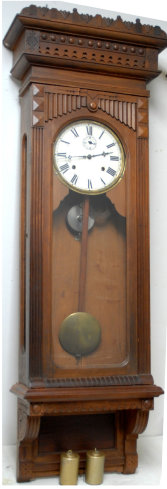
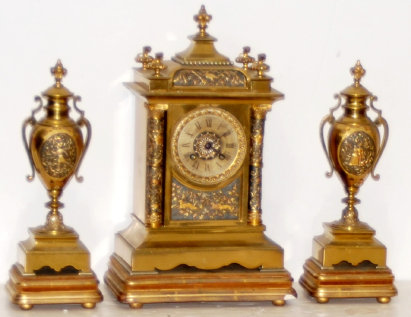
99D. $750
Congreve Rolling Ball Clock a working copy of the original fusee
clock invented by William Congreve in 1808. It uses a ball rolling instead of a pendulum to regulate the time. The ball rolls
down a zig zag track where it trips the escapement which in turn reverses the tilt of the tray and the ball rolls the other way. Information
I was able to glean from the internet said the Congreve clocks are unreliable timekeepers. I keep it on my desk, not as a time
keeper but the rolling ball noise to keep me awake. This clock has a bright 24K gold plating, even the winding key. The glass display
case has a hinged front door to open for easy winding. The wood base with drawer is a beauty in itself. The picture showing
the glass case I plagiarized from the internet. My glass case is safely stored in its shipping carton and I did not wish to remove
all the packing. The clock is on my desk with the ball rolling constantly. I have never checked the porcelain dials to see if it is
keeping time, for frankly I don’t care as there are many other timekeeping clocks hanging and ticking everywhere. $800-$1000.

99E. $2500
“Seth Thomas, Thomaston, Conn.”, printed on the label of this
hanging, “Regulator No. 1 Extra”, ca 1865. I have several early trade catalogs dating back to 1863, and this model was pictured in
the 1863 catalog. The Thomaston or Plymouth Hollow on the label also dates the clock back to the 1860’s. Rosewood veneered case is
44” high, complete with all original parts and one of the nicest No. 1 Extra’s I have ever offered for sale. It has been in my collection
of near perfect Seth Thomas clocks that I thought I would never sell. On the outside are the doors with original glass, key locking
lower door taking a male end key, and a locking knob on the bezel. The veneer is exceptional and if repairs have been made to the
case, and it is reasonable to think there were, I cannot detect them. The only change I see to the entire clock is a Dial House repainted
dial. The hands, special brass bob with engraved picture of the ST factory, gold stick, male end key, sliding weight partition, beat
scale, and the two old weights, are all near perfect and original. The 8 day time and strike movement is identical to the movement
pictured in Ly-Seth Thomas #846-A. Other photos of the No. 1 Extra are on pages 272-273. This clock had been hanging in the home of
a long time collector until removed to our location where it has been in my collection. Mr. Ly’s panel of experts gives the No. 1
Extra Time and Strike with the special pendulum bob, a book value of $5000 (in 2005). Our experience has shown that this model in
excellent condition should bring $4000-$6000 (in 2005). Some of my family hopes this clock does not sell. $2500-$3500.
99C. $750
French three piece bronze set, ca 1880. The 8 day round French
movement is signed, “Japy Freres”. It is typical of most all French movements of that period, striking half hours and hours on a standing
gong. A hinged bronze door covers the back opening. The clock case is 13.5 inches high and the side pieces are 11 inches high, not
including the 2 inch high bases. All three pieces sit on a base that is covered with gold gilt around the edges. Each of the pieces
has bun feet and is signed underneath in several coded ways. Maker’s numbers I suppose. The large base has some chips on the corners.
I am just a rookie in the clock business but over my 45 years collecting and selling clocks I have never seen a three piece set with
bases. The front of all three bronze pieces are intricately decorated with animals and foul. The dial ring is slightly soiled and
should clean up easily. The hands are correct, as are the pendulum and key. $1000-$1500.
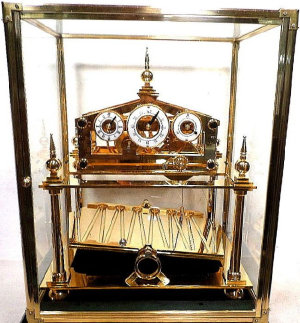
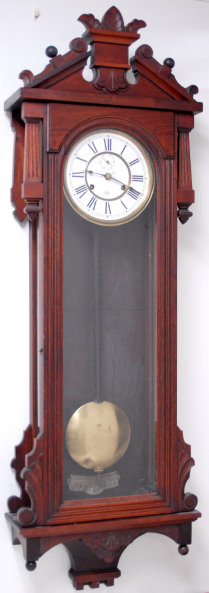
99F. $800
Ansonia Clock Co. wall clock, “Prompt”, ca 1901. One hundred
percent original walnut or mahogany case, 50” high, has no repairs or new wood. I can usually distinguish between walnut and mahogany,
but this case is smoky dark, has not been cleaned or polished in a while, but I am going to go with walnut. I can see the wood grain
plainly, but not the wood color clearly. As you can see there is a large glass in the door and side glasses. All the clock parts are
unquestionably original, the 8 day two weight time movement, signed two piece dial with seconds dial, three hands, pendulum bob, wood
stick, and a signed beat scale. The movement is signed and is in running condition but the left weight cord is not in the pulley groove.
Don’t wind it until you put it in the groove. If you want an original clock, this one is certainly all original. Ly-Ansonia
#599. $1000-$1500.
99B. $500
Wm. L. Gilbert Clock Co. “No. 11 Regulator”, ca 1891. We have
sold a good many of this model over the years always with great success for it has always been a popular clock. This clock may not
be the finest of this model we have sold but there is loads of money making potential for a woodworker. The 50” high case is made
of solid cherry and has not been loved like most No. 11’s we have sold. The problems I see are not major. Four of the wood balls on
top and five small wood strips below the balls, are missing. All the other wood parts of the case look to be original, no repairs
or new parts visible. Some of the wood work is very detailed and most unusual. There is a door lock on the side, old winding crank,
pair of iron weights and brass pendulum with the original wood stick. The weights run the clock okay but are not correct. I did not
hang the weights for the picture. The paper dial is a replacement and I cannot vouch for the hands. The movement is 8 day, time and
strike, mounted to a large iron back plate, and is powered by the two weights that descend each side of the case. The weight cords
are wound around one spool on the bottom of the movement, then the cords go up to the top right, one crossing over the top of the
movement to the left side, then both descend each side of the case. As you know we have always sold this model, in very nice condition,
around $2500-$3500. Ly-Gilbert, page 135. $750-$1000.


99G. $2000
Seth Thomas Clock Co. “Regulator No. 20”, ca 1909. A very large
mahogany finished case that stands 62” high and is more than one man can handle. For the most part it is 100% original. It has been
polished with some of the modern products that also take some of the smoke off the wood. The books say the tops were made to be removed
if a plain top is desired. My top is identical to the original in every respect, including the type screws used to hold the finials
and top in place for it is removable if you like the flat top better. The large movement is mounted to an iron bracket, it is 8 day
time only with Graham dead beat escapement and maintaining power. Large brass covered zinc ball (pendulum to us), long wood rod, knurled
brass weight, brass pulley, and brass beat scale, are all original. The brass dial ring matches the other brass accessories. There
are three correct hands, and the 14” painted dial, are also original. The signed dial has some flaking pretty well all over. In good
condition this clock will usually sell for $5000 or more. (Used to) Ly-Seth Thomas, page 304. $2500-$3000.

99H. $1200
Southern Calendar Clock Co. “Fashion No. 4”, ca 1880. The Culver
brothers started this company in 1875 and the best marketing decision they made was to contract with the Seth Thomas Clock Co. for
the running and calendar movements for the Fashions. Most experts agree that the movements used in the Fashion clocks were the finest
Seth Thomas ever made. The clock is running and keeping time as designed. The four hands, upper and lower dial, nickeled bezels, calendar
rollers, and Fashion glass, are all original and correct. The pendulum rod has had a piece of reinforcement metal added but you cannot
see that in the clock. It is very unusual that these original dials have only some minor paint chips. Usually by now both dials would
have been so bad they had to be repainted. The walnut case is 32” high, complete and original. All three finials have good tips and
we cannot verify if there are factory lathe marks on the ends because they are glued into the case. There is a complete black label
inside, the movements are clean, signed, and running. Overall a good example of the No. 4. Ly-Calendar, page 286. $1500-$2000.
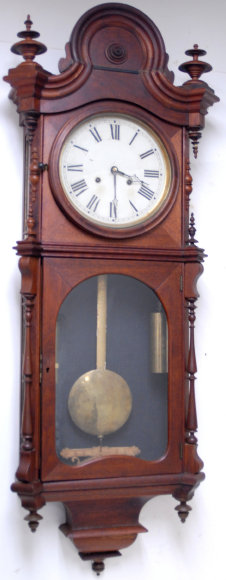
99J. $2500
Welch, Spring & Company, “Regulator No. 5”, ca 1873-1884.
The No. 5 Regulator uses an eight day nickel plated movement with double springs. The front plate is stamped, “E. N. Welch, Forestville,
CT. U.S.A.”. This is the same movement that was sold to the Ithaca Calendar Clock Company for use in some of their clocks. This is
another fine clock from the northeast doctor’s collection. He acquired his clocks many years ago, buying only the best of the rare
models. It has the original finish, very dark with some crazing, needs to be polished and some small details attended to. The walnut
case stands 52 inches tall. Complete with all the correct fragile finials, two original glasses on each side, inside gold frames,
original glasses in the two front doors, and overall the case is very nice. It has an original painted dial that is near perfect,
correct hands, pendulum bob, gold wood stick, and key. The bottom door is key lock, with key, escutcheon is missing. We have not seen
this model previously, and if they are out in collections, we do not see how they could be a whole lot nicer than this one. Ly-Welch,
page 98-99. $3000-$5,000.
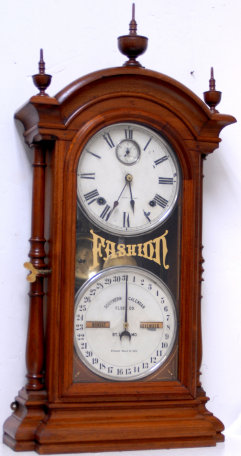
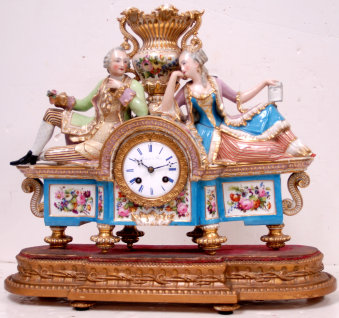
99K. $1100
Large two piece French porcelain clock by, “Breguet a’
Paris”. The dial and movement are both signed the same. The movement also has a serial number, “495”. Breguet was making clocks in
Paris in the early to mid-1800’s. There are no visible missing, repaired, or broken pieces. All the fingers, toes, and other sharp
edge points, are all intact. Nice colors on the porcelain as well as gold highlights. The French couple is lollygagging in the flower
garden, probably discussing the next French election. The clock sitting on the fancy wood base is 16 ½ inches tall, and 19 inches
wide at the base. It has a very nice porcelain dial and original correct French hands. The clock is in running condition, but we did
not run it most of the time we had it. I would recommend you oil it if you plan to run it regularly. We never see these fine French
clocks for sale anymore. $2000-$3000.
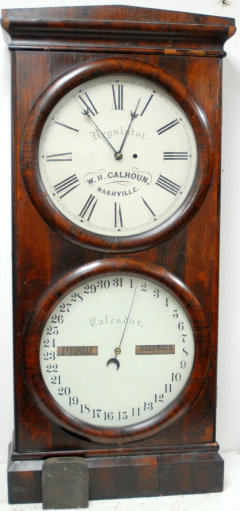
99L. $950
Seth Thomas Clock Co. “Office Calendar No. 2”, ca 1875. This
is a very large rosewood veneered case standing 42.5” tall, in very nice condition. It came from a collector of a house full of awfully
nice and valuable clocks. One day recently we had over 600 rare clocks come in from 2 collectors. This case has some light veneer
damage, mainly the top, base, and rounded rings around the dials. This is a complete clock and a good restoration project for someone
who can repair a few veneer chips. The movements, dials, weight, and pendulum bob, are correct or original for this model clock. The
painted dials are 14.5” in diameter, there are good hands, and inside on the back of the door is a large black and gold label, all
intact. It is signed, “Seth Thomas Clock Company, Plymouth Hollow, Conn.”. The time movement is 8 day, powered by one wafer weight
that descends a weight chute on the right side of the case. The calendar movement is perpetual. The door lock on the case side requires
a male ended key to operate the lock. One will be with the clock. A beautiful and large clock. I cannot believe how few of this
model we have sold in 45 years. Ly-Calendar, page 247. $1000-$1500.